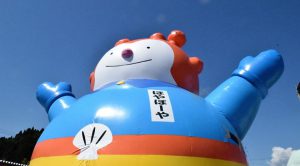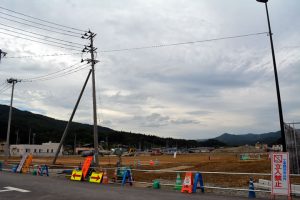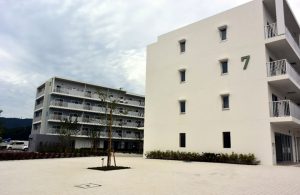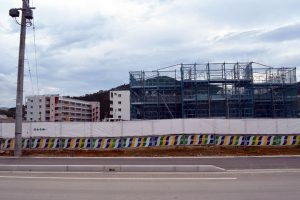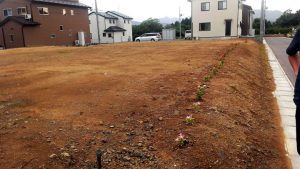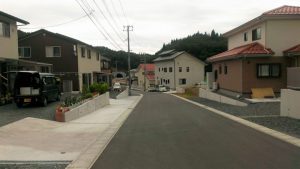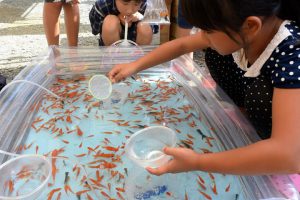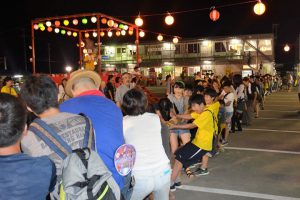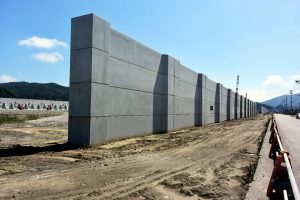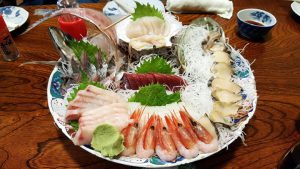[Original by Harune TANAKA, 2016 Public Relations Intern (October 3, 2016); Translated by M. Kanai/R. Florea/M. Takahashi]
Hello everyone, Good afternoon. My name is Harune Tanaka, 2016 Public Relations Intern, currently in charge of JVC’s website. I am a 4th year student at university and doing volunteer work at JVC Tokyo office as an Intern responsible for updating the website. Usually, my job is to put articles written by others up on the website. It is my first time to contribute an article myself, therefore I feel a little nervous.
In August 2016, I visited Kesennuma City, which is one of the JVC’s operation fields, together with Ms. Ohmuro, Intern for Palestine project, Ms. Nishikawa, another Intern for Public Relations, and Ms. Kuwana, Intern for South Africa project. During the trip we were able to carry out our observation itinerary blessed with the weather, which was quite pleasant with temperature not too hot (much cooler in comparison with Tokyo).
I would like to report from my own point of view about the current state of the Kesennuma-area that was hit by the Great East Japan Earthquake five years ago (March 11, 2011) based on the findings during the short three-day trip.
(Note: “Hoya”, ascidian, is one of the local marine specialties in Sanriku costal area that stretches from Iwate to Miyagi prefecture.)
Construction of new houses
On the first day of our observation trip, Mr. Iwata and other local staff of JVC Kesennuma office guided us around the operation field and the towns affected by the earthquake and tsunami disaster.
In the wake of the disaster, land elevation work has been underway in a number of areas in Kesennuma city. We often came across those construction sites during our observation trip. (Land elevation is carried out to raise the ground level of the area where the land subsided due to the earthquake. Around the building sites for public housing complex in Shishiori district, the ground level was elevated by 3.5 meters.) The level of the elevated ground at first glance seemed not as high as I expected. Then, I was told that it was because the entire land in the area was raised.
Then, we observed public housing complex for disaster evacuees built by Kesennuma city, and privately owned houses newly constructed.
Evacuees’ move-in to the completed public housing complex shown above started late July, therefore, only a few people live at present. The buildings look quite modern. Since there are no such apartment type buildings in the surrounding area, the buildings somehow stand out as if they are isolated around there.
Residential zones developed in the upland area have wider roads with slow curve so that respective houses can be easily seen. In urban residential districts, on the other hand, houses are usually built close to each other and roads are narrower. In the upland residential zones in Kesennuma, you can find various ideas incorporated into the community planning because residents discussed the rules for community development prior to the construction of their houses. In some area, the residents planted flowers alongside the roads. Before visiting the area, I expected to see many houses standing packed in a narrow land space, but what I found instead was a kind of place I wish to live in.
Shishiori Bon Festival Dance for Reconstruction organized by local people for the first time in five years after the disaster!
(Note: “Bon” is the Buddhist All Souls Day.)
On the second day of our observation trip, we took part in the festival lending our helping hand. We cooperated with students of a local high school in a goldfish scooping game, selling shaved ice, beverages and sugar floss.
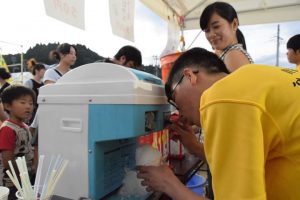
Ms. Ohmuro, an intern for Palestine project, watching warmly over a high school student working hard with ice shaver.
On the first day of our trip, we went on cycling in the town during free time. On that occasion, we did not come across or see young people at all, especially children, although it was during summer holidays. But on the following day, a lot of children gathered together at the festival site.
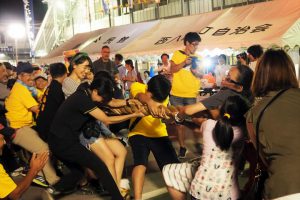
Everyone frantically pulling the rope with all his/her force! Festival in full swing with joy and excitement!
Noteworthy about this year’s Shishiori Bon Festival Dance for Reconstruction is that the local people organized it for the first time since the 2011 disaster. It marks the start of a new phase of post-disaster reconstruction. It has significance to those affected by the disaster in their own ways: entry to the newly constructed public housing complex, farewell to Shishiori Fukko mart, consolation of the spirits of those who died in the disaster, and opening of a town to welcome those who will come back to Shishiori ending their evacuation life. This festival was meant to fulfill the various purposes and wishes of the local people.
(Note: ”Shishiori Fukko mart” means “a marketplace to restore happiness in Shishiori district” in Japanese.)
Amid starting a new life ……
Since a lot of people living in the district participated in the festival, I took this opportunity to mingle with them. I talked with a resident of a public housing complex, the entry to which just started in July. Firstly, I asked the person whether it is comfortable to live in the public housing complex or not. “I feel lonely” was the first word she said in responding to my question. She used to live in a temporary housing for the quake- and tsunami-displaced persons. Initially, the neighbors were all strangers but gradually she started to have conversation with them and after a while enjoyed frequently chatting with them. But now, at public housing complex, she has almost no contact with people in the neighborhood. Moreover, she was shocked to know that the residents of the housing complex seem to have no interest in getting acquainted with the neighbors. She says that the building of the public housing complex is not suited to the lifestyle in countryside but rather suited to that of urban areas. She says it took so much trouble to obtain a new dwelling here, but somehow, she cannot have easy and relaxed life here. She feels very lonely because there is no connection with other people living nearby, thus making the life dull and inactive. Listening to her talk I realized that merely getting a place to live is not enough for them to become happy, having favorable relations with other people may be more important.
Then, I had a chance to talk with a person who used to run a shop in Shishiori Fukko mart. According to her, she intends to close her shop at the same time when the mart is closed completing its role as a temporary shopping center. A new shopping area is to be opened in a developed district where land elevation work was carried out. But she finds it difficult to start a shop in the new place, considering her age and financial burden for opening a new shop. She still lives in a temporary housing. But she is planning to move to a public housing complex built by Kesennuma city in the future. Since she has been living in a one-storied home all her life till now, her worries are growing over living in a multi-storied public housing.
Although I could talk to only two local people during the trip, the stories about their current situation made me realize how important it is to support them in various aspects: preparing the foundations of their life such as community development, provision of the type of housing which meets the needs of the respective inhabitants, besides providing material support. At the same time, I was convinced once again of the significance of the support activities carried out by JVC Kesennuma office to help the disaster victims with livelihood rehabilitation, community development and managing their temporary living.
Some thought that came to my mind by visiting the affected area after five years of the disaster
The great earthquake struck the east Japan was accompanied by a giant tsunami, which is said to hit Japan every 1000 years. During the trip, we visited the site where they are building the new tide embankment. I noticed, however, that even if the embankment is constructed, it does not block the same level of tsunami because of its limited height. Besides, since the durability of concrete is estimated to be 50 to 60 years, construction work has to be repeated accordingly, which requires vast amount of money. Looking at the gigantic wall, Mr. Iwata, JVC staff at Kesennuma office, said that “there is no such thing as perfect tide embankment.” It was deeply imprinted on my mind. Once there were people catching fish for living. There used to be a sea here, but now a massive concrete structure is obstructing the view. With all these sacrifices, the wall cannot cope with future tsunami of the same height that took place in 2011. I cannot help wondering whether the construction of the tide embankment is meaningful and whether the completed wall could protect the people living there if another mega tsunami would hit the area.
I found out two things during the trip. Firstly, recovery works of the disaster-hit areas require an enormous amount of time, by far longer than we can imagine. Before I came here, I thought that almost all the temporary housing had been already closed and removed. But the reality that I have observed is that there are still people living in temporary housing and people running a makeshift shop while living there. The sight made me think anew about the incredible length of time needed for reconstruction process. Because of the disaster, the local people had to face various changes taking place in every aspect of their environment including their houses, jobs, valuable community ties. Even though they know that nothing can be restored as before, they are doing their utmost to start a new life. I was able to directly experience and feel the strong willpower of the local people.
Secondly, I found out the difficulty in providing the support truly needed by the people concerned. Provision of places to live by constructing towering, gigantic tide embankment along the coastline, or rebuilding community in new residential areas will not be enough to satisfy the needs of the people. Post-disaster way of living and community ties should also be given consideration. Even after having obtained a new house at long last, they have to start a new community life together with other new residents from the scratch in an unfamiliar environment. It requires tremendous patience and perseverance. It is reality that they cannot have their old life back. For this very reason, assistance measures should be formulated in a manner specifically and precisely focused on the requirement of those people.
Today, five years after the disaster, coverage of the disaster-hit areas by mass media is gradually decreasing. However, because Japan is an earthquake-prone country, there are many lessons we should learn from the Great East Japan Earthquake in order to prepare for major earthquakes predicted to come in the future. How the disaster recovery activities have been carried out for the past five years and in what manner recovery work is to be continued including community development in a new place— These are the issues not limited only to the people affected by the disaster, but the rest of us living on the Japanese archipelago should also think about.
Additional episode! Delicacies of Kesennuma…
During the trip, we were very active not only in observing various places of JVC’s operation fields but also eating a lot of delicious local foods. Since this area is located close to the sea, fresh seafood is exquisite! I would like to introduce the delicious food we enjoyed in Kesennuma.
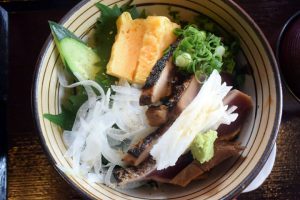
A bowl of rice topped with lightly grilled bonito! A generous serving! Taste of bonito enhanced by Wasabi.
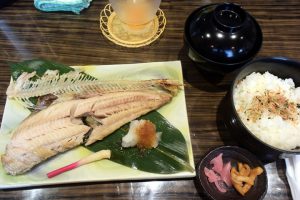
A set of meal consisting of broiled Okhotsk mackerel juicy with fatty meat, bowl of rice, soup and pickles.
(Note: Wasabi is similar to horseradish, grated and eaten with sliced raw or lightly grilled fish)
Besides the above, we ate “Hoya”, ascidian, depicted as a mascot of Kesennuma and “Star of Mouka”, that is a heart of salmon shark (called Mouka shark in Japanese). Although we also eat various kinds of fresh seafood in the Kanto area, the taste of seafood is different when we eat them at the place of origin. Absolutely delicious! It is quite difficult to express the difference of the taste in words, so please visit Kesennuma and try them.
A photo taken at the end of the trip
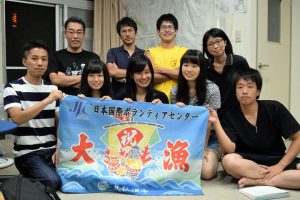
We would like to express our gratitude to all staff members of JVC Kesennuma office for their valuable help and kind hospitality.

